Alcyone, Eta Tauri (η Tau) is a multiple star system located in the constellation Taurus, the Bull. With an apparent magnitude of 2.87, Alcyone is the third brightest star in Taurus, after Aldebaran and Elnath, and the brightest star in the Pleiades cluster (Messier 45), one of the nearest open clusters to Earth. The star lies at an approximate distance of 440 light years from Earth.
Star system
Eta Tauri is listed as a multiple star system in the Washington Double Star Catalog (WDS) and the Catalog of Components of Double and Multiple Stars (CCDM). The latter catalog lists the primary component, formally named Alcyone, and three companions. Alcyone B (24 Tauri) is a white (A0) main sequence star with an apparent magnitude of 6.28, located at a separation of 117’’ from the primary component. Alcyone C has the variable star designation V647 Tauri and is classified as a Delta Scuti variable. Its brightness varies from magnitude 8.25 to 8.30 with a period of 1.13 hours. Alcyone D is a white (F3) main sequence star with a visual magnitude of 9.15.
The Washington Double Star Catalog lists Alcyone D as a double star with two similar components separated by only 0.3’’. The catalog lists four other fainter stars in the system, none of them brighter than magnitude 11.
The primary component in the system is a triple star. The brightest component is a bluish (class B7IIIe) giant star with a mass between 5.9 and 6.1 solar masses and a radius about 9.3 times that of the Sun. With an effective temperature of 12,258 K, the star is 2,030 times more luminous than the Sun, but most of its output is in the invisible ultraviolet part of the spectrum. Alcyone is a Be star and, like all the named Pleiades except Maia, it is a very fast spinner, with a projected rotational velocity of 149 km/s. As a result, it is surrounded by a disk of gas ejected around the equator.
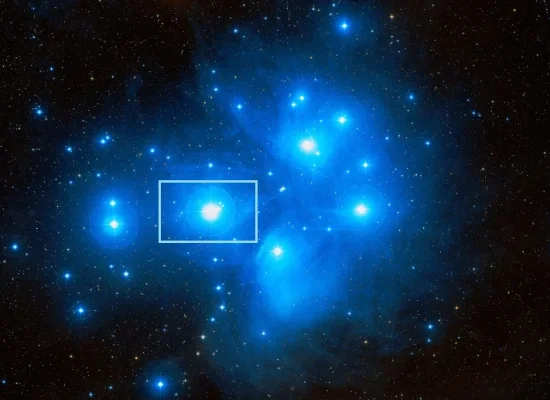
Alcyone (Eta Tauri), image: Wikisky
The nearest companion is a low-mass star separated by less than 1 milliarcsecond from the primary. The two components orbit each other with a period of a little over four days. The other companion is located at a separation of 0.031 arcseconds (roughly the distance from the Sun to Jupiter). It is half as massive as the primary. The two have an orbital period of about 830 days.
Pleiades
Alcyone is the brightest member of the Pleiades open cluster. The nine brightest stars in the cluster are named after the Pleiades, the Seven Sisters in Greek mythology – Alcyone (Eta Tauri), Asterope (21 Tauri), Celaeno (16 Tauri), Electra (17 Tauri), Maia (20 Tauri), Merope (23 Tauri) and Taygeta (19 Tauri) – and their parents Atlas (27 Tauri) and Pleione (28 Tauri).
The Pleiades open cluster contains more than 1,000 confirmed members and has a total mass of 800 solar masses. The brightest members are hot blue stars of the spectral type B with an estimated age of up to 100 million years. They lie at an average distance of 444 light years from Earth.
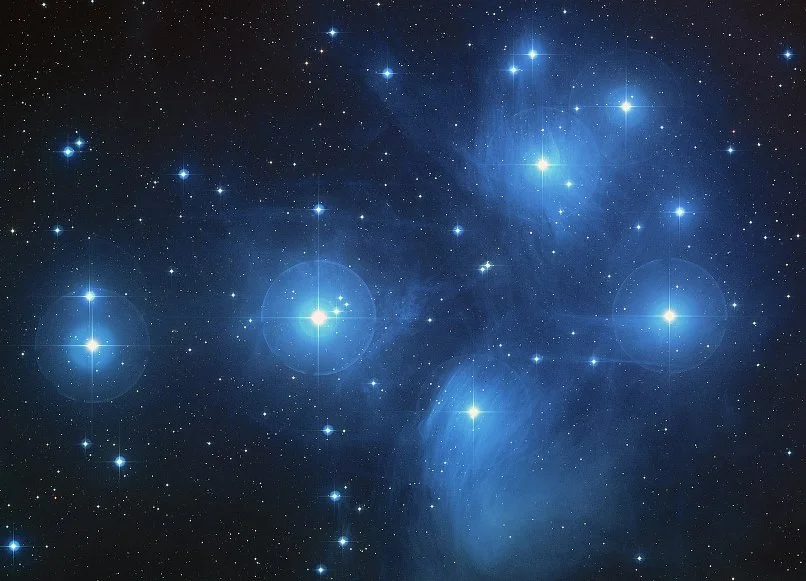
The Pleiades (M45), image: NASA, ESA, AURA/Caltech, Palomar Observatory, credit: D. Soderblom and E. Nelan (STScI), F. Benedict and B. Arthur (U. Texas), and B. Jones (Lick Obs.)
Catalogued as Messier 45 by the French astronomer and comet hunter Charles Messier, the cluster is exceptionally bright and large, occupying an area of 110 arcminutes. It has an apparent magnitude of 1.6 and is the most recognizable star cluster visible without binoculars. Up to 14 members are visible in exceptionally good conditions, but observers normally see six to eight stars.
The members will likely keep travelling together through space for another 250 million years and then gradually disperse as a result of gravitational interaction with the interstellar medium.
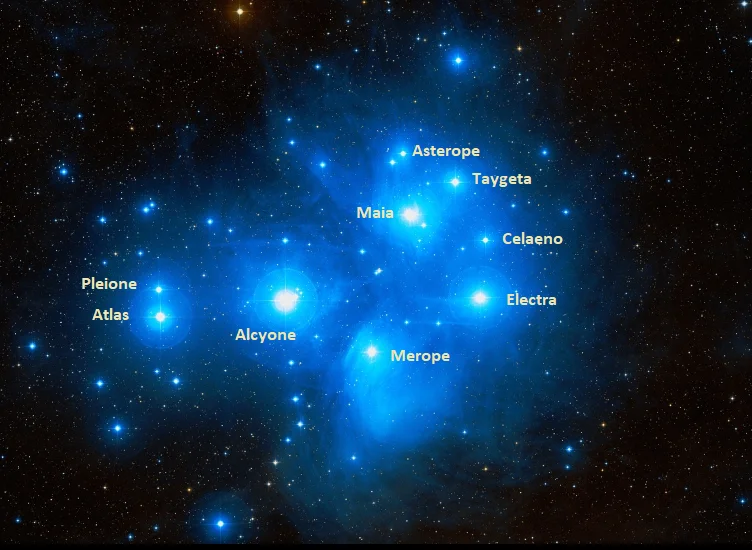
The Pleiades, image: Wikisky
In Greek mythology, the Pleiades caught the eye of Orion, the hunter. After their father Atlas was condemned to carry the heavens on his shoulders, Orion began to pursue the sisters. Zeus intervened, transforming the sisters first into doves and later into stars. The constellation Orion still appears to be pursuing the Pleiades across the sky.
Facts
The Pleiades have been a familiar feature of the night sky in cultures around the world. The earliest discovered depiction of the cluster is the Nebra sky disk, a Bronze Age artifact found in Germany that dates back to around 1600 BCE. The stars were notably mentioned in the Bible, the Greek poet Hesiod’s Works and Days, and Homer’s Iliad and Odyssey.
The first astronomer to observe the Pleiades through a telescope was Galileo Galilei, who discovered that the cluster contained many other stars too faint to be visible to the unaided eye. Galilei published his notes along with a sketch in March 1610.
In 1782, the French astronomer Edme-Sébastien Jeaurat drew a map of 64 members of the cluster and published it in 1786.
In Japan, the cluster was mentioned as Mutsuraboshi, meaning “six stars,” in the 8th century Kojiki (“An Account of Ancient Matters”). Today, the Japanese know the Pleiades as Subaru. The automobile company Subaru uses an image of the six brightest stars in its logo.
Name
The name Alcyone (pronunciation: /ælˈsaɪəniː/) comes from Greek mythology. Alcyone was one of the Pleiades, the seven daughters of the Titan Atlas and the sea-nymph Pleione. The seven sisters were nymphs and companions of the goddess Artemis. Alcyone had three children by Poseidon: Hyrieus, Hyperenor, and Aethusa. The name Alcyone (Greek: Ἁλκυόνη) was derived from the Greek αλκυων (alkyon), meaning “kingfisher.”
The name was officially approved for the star by the International Astronomical Union’s (IAU) Working Group on Star Names (WGSN) on June 30, 2016. It formally applies only to the component Eta Tauri A.
The Chinese know Alcyone as 昴宿六 (Mǎo Xiù liù), meaning “the Sixth Star of Hairy Head.” Hairy Head is a Chinese asterism consisting of the Pleiades stars Asterope, Atlas, Electra, Maia, Merope, Taygeta, and Alcyone. The asterism is one of the seven mansions of the White Tiger.
Location
Alcyone is easy to find because it is a member of one of the most recognizable features of the night sky. The Pleiades can be found by following an imaginary line extended from the stars of Orion’s Belt – Alnitak, Alnilam and Mintaka – but most observers will likely spot the cluster without any help because it is exceptionally large and bright.
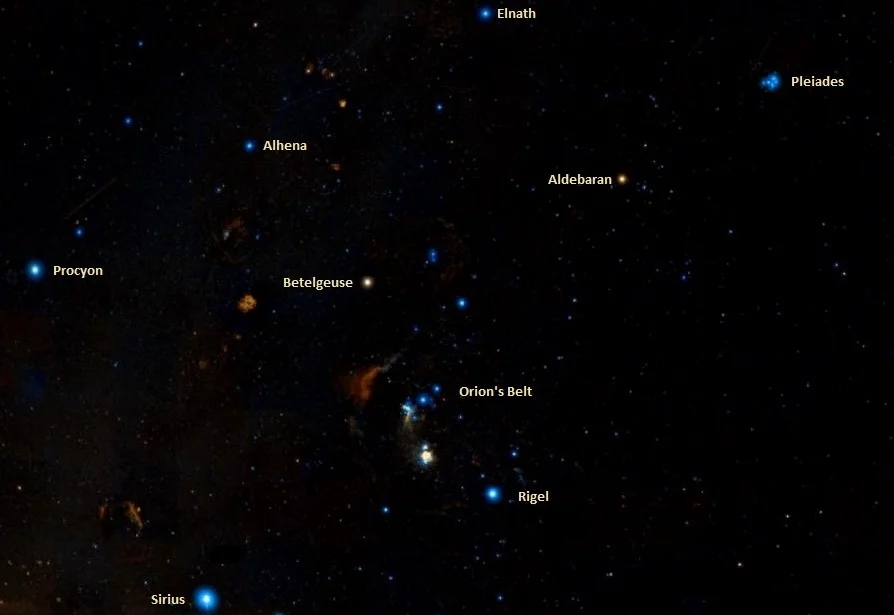
Pleiades location, image: Wikisky
The cluster is conspicuous in the sky from October to April. It is invisible in May and June, when it is too close to the Sun.
Constellation
Alcyone is located in the constellation Taurus. Representing the celestial Bull, Taurus is one of the largest constellations in the sky, covering an area of 797 square degrees. It is best known for its brightest star, Aldebaran, the 14th brightest star in the sky, and the two bright, large open clusters, the Pleiades and the Hyades. Aldebaran marks the Bull’s eye and the V-shaped Hyades cluster outlines its head.
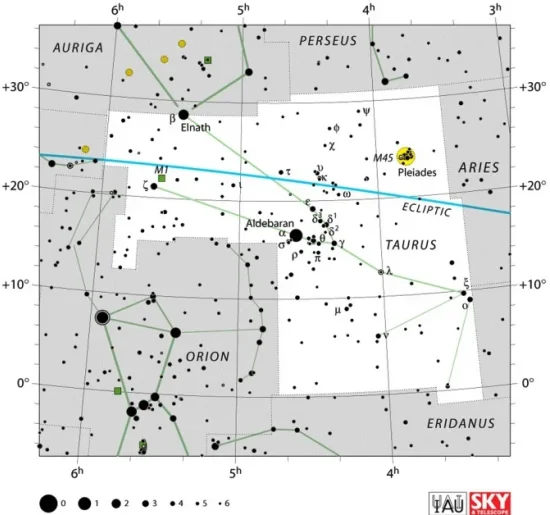
Taurus constellation map by IAU and Sky&Telescope magazine
Taurus is home to several other well-known deep sky objects: the historic supernova remnant Messier 1, also known as the Crab Nebula, the Spaghetti Nebula (a large but faint supernova remnant), the reflection nebulae NGC 1555 (Hind’s Variable Nebula) and the Baby Eagle Nebula (LBN 777), the planetary nebula NGC 1514 (Crystal Ball Nebula), the colliding galaxies NGC 1409 and NGC 1410, and the open clusters NGC 1647 and NGC 1817.
The best time of year to observe the stars and deep sky objects of Taurus is during the month of January.
The 10 brightest stars in the constellation are Aldebaran (Alpha Tau, mag. 0.86), Elnath (Beta Tau, mag. 1.65), Alcyone (Eta Tau, mag. 2.87), Tianguan (Zeta Tau, mag. 2.97), Chamukuy (Theta2 Tauri, mag. 3.40), Lambda Tauri (mag. 3.47), Ain (Epsilon Tau, mag. 3.53), Omicron Tauri (mag. 3.61), Atlas (27 Tau, mag. 3.63), and Prima Hyadum (Gamma Tau, mag. 3.654).
Alcyone – Eta Tauri
| Spectral class | B7IIIe |
| U-B colour index | −0.34 |
| B-V colour index | −0.09 |
| Apparent magnitude | 2.87 |
| Absolute magnitude | -2.62 |
| Distance | 443.5 light years (136 parsecs) |
| Parallax | 8.09 ± 0.42 mas |
| Radial velocity | 5.40 km/s |
| Proper motion | RA: 19.34 ± 0.39 mas/yr |
| Dec.: -43.67 ± 0.33 mas/yr | |
| Mass | 5.9 – 6.1 M☉ |
| Luminosity | 2,030 L☉ |
| Radius | 9.3 ± 0.7 R☉ |
| Temperature | 12,258 K |
| Rotational velocity | 149 km/s |
| Surface gravity | 3.047 cgs |
| Constellation | Taurus |
| Right ascension | 03h 47m 29.077s |
| Declination | +24° 06′ 18.49″ |
| Designations | Alcyone, Eta Tauri, η Tau, 25 Tauri, HD 23630, HR 1165, HIP 17702, GC 4541, GCRV 2135, SAO 76199, FK5 139, PPM 92898, BD+23 541, BDS 1875, CCDM 03474+2407, ALS 15094, IRAS 03445+2357, 2MASS J03472908+2406184, TYC 1800-2202-1, WDS J03475+2406A, Gaia DR2 66714384141781760 |